fuse TOYOTA SEQUOIA HYBRID 2023 Owners Manual
[x] Cancel search | Manufacturer: TOYOTA, Model Year: 2023, Model line: SEQUOIA HYBRID, Model: TOYOTA SEQUOIA HYBRID 2023Pages: 628, PDF Size: 14.27 MB
Page 4 of 628
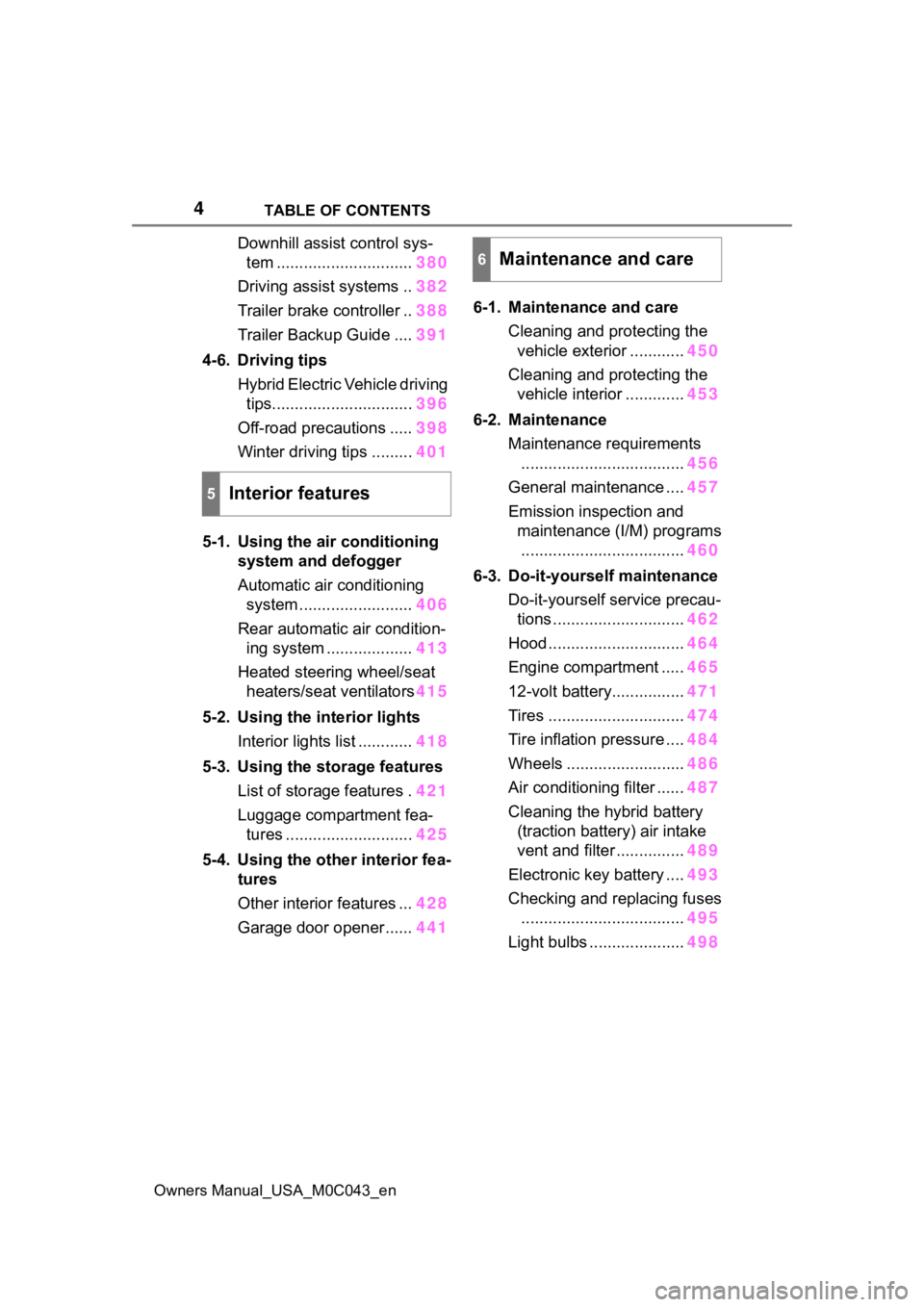
4TABLE OF CONTENTS
Owners Manual_USA_M0C043_en
Downhill assist control sys-tem .............................. 380
Driving assist systems .. 382
Trailer brake controller .. 388
Trailer Backup Guide .... 391
4-6. Driving tips Hybrid Electric Vehicle driving tips............................... 396
Off-road precautions ..... 398
Winter driving tips ......... 401
5-1. Using the air conditioning
system and defogger
Automatic air conditioning system ......................... 406
Rear automatic air condition- ing system ................... 413
Heated steering wheel/seat heaters/seat ventilators 415
5-2. Using the interior lights Interior lights list ............ 418
5-3. Using the storage features List of storage features . 421
Luggage compartment fea- tures ............................ 425
5-4. Using the other interior fea- tures
Other interior features ... 428
Garage door opener...... 4416-1. Maintenance and care
Cleaning and protecting the vehicle exterior ............ 450
Cleaning and protecting the vehicle interior ............. 453
6-2. Maintenance Maintenance requirements.................................... 456
General maintenance .... 457
Emission inspection and maintenance (I/M) programs.................................... 460
6-3. Do-it-yourself maintenance Do-it-yourself service precau-tions ............................. 462
Hood .............................. 464
Engine compartment ..... 465
12-volt battery................ 471
Tires .............................. 474
Tire inflation pressure .... 484
Wheels .......................... 486
Air conditioning filter ...... 487
Cleaning the hybrid battery (traction battery) air intake
vent and filter ............... 489
Electronic key battery .... 493
Checking and replacing fuses .................................... 495
Light bulbs ..................... 498
5Interior features
6Maintenance and care
Page 434 of 628
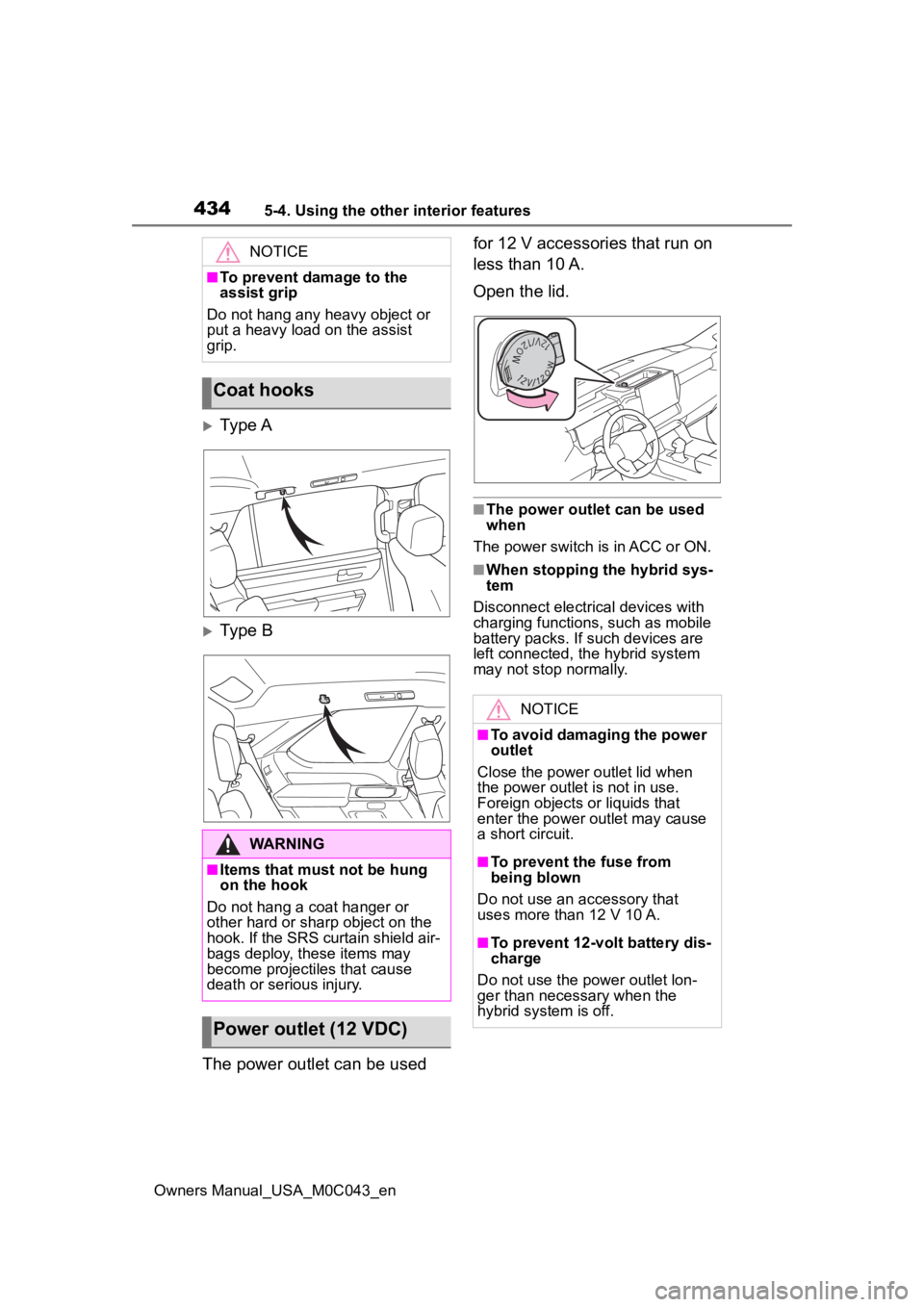
4345-4. Using the other interior features
Owners Manual_USA_M0C043_en
Ty p e A
Type B
The power outlet can be used for 12 V accessories that run on
less than 10 A.
Open the lid.
■The power outlet can be used
when
The power switch is in ACC or ON.
■When stopping the hybrid sys-
tem
Disconnect electrical devices with
charging functions, such as mobile
battery packs. If such devices are
left connected, the hybrid system
may not stop normally.
NOTICE
■To prevent damage to the
assist grip
Do not hang any heavy object or
put a heavy load on the assist
grip.
Coat hooks
WARNING
■Items that must not be hung
on the hook
Do not hang a coat hanger or
other hard or sharp object on the
hook. If the SRS curtain shield air-
bags deploy, these items may
become projectiles that cause
death or serious injury.
Power outlet (12 VDC)
NOTICE
■To avoid damaging the power
outlet
Close the power outlet lid when
the power outlet is not in use.
Foreign objects or liquids that
enter the power outlet may cause
a short circuit.
■To prevent the fuse from
being blown
Do not use an accessory that
uses more than 12 V 10 A.
■To prevent 12-volt battery dis-
charge
Do not use the p ower outlet lon-
ger than necessary when the
hybrid system is off.
Page 449 of 628
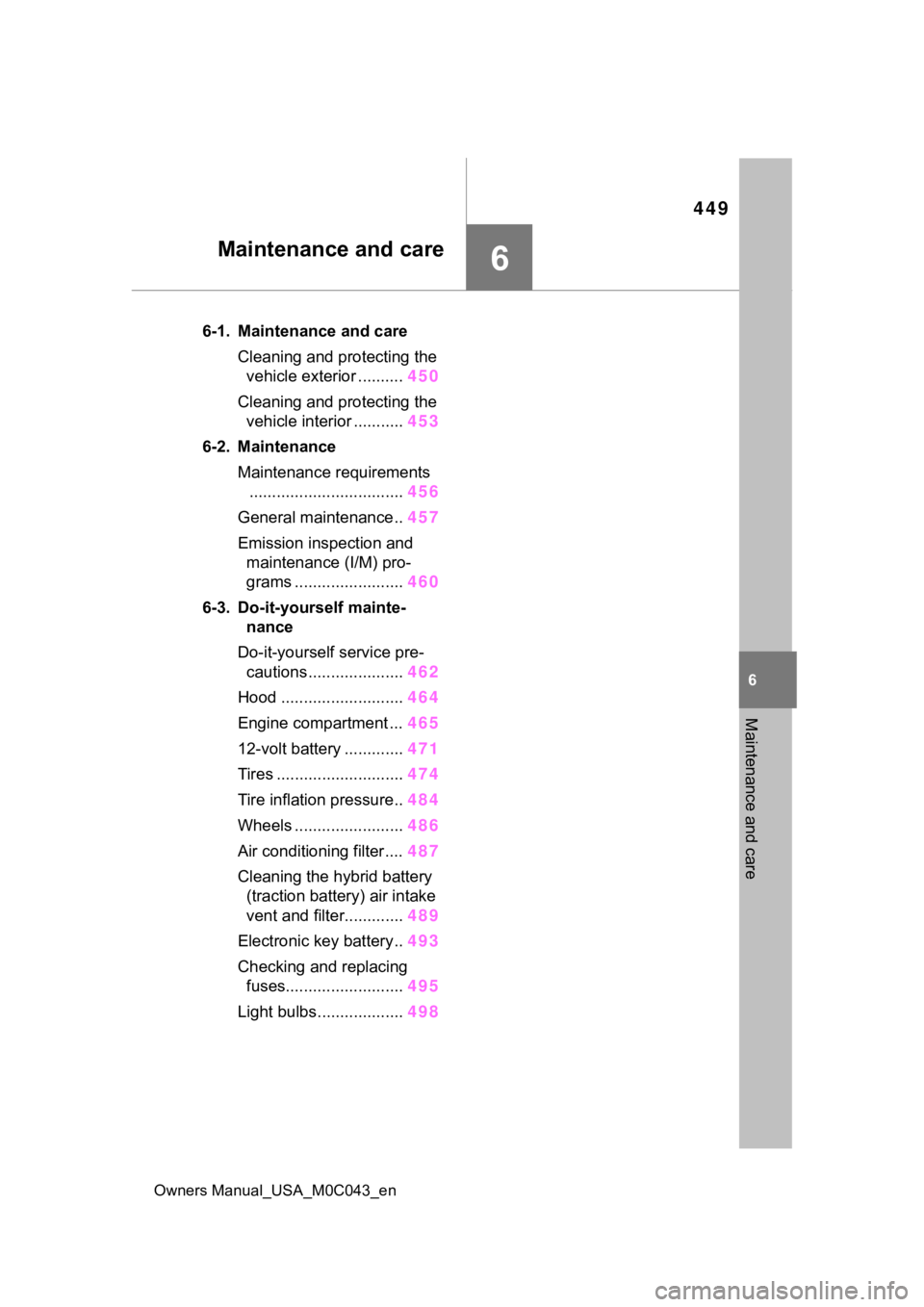
449
Owners Manual_USA_M0C043_en
6
6
Maintenance and care
Maintenance and care
6-1. Maintenance and careCleaning and protecting the vehicle exterior .......... 450
Cleaning and protecting the vehicle interior ........... 453
6-2. Maintenance Maintenance requirements.................................. 456
General maintenance.. 457
Emission inspection and maintenance (I/M) pro-
grams ........................ 460
6-3. Do-it-yourself mainte- nance
Do-it-yourself service pre- cautions ..................... 462
Hood ........................... 464
Engine compartment ... 465
12-volt battery ............. 471
Tires ............................ 474
Tire inflation pressure.. 484
Wheels ......... ...............486
Air conditioning filter .... 487
Cleaning the hybrid battery (traction battery) air intake
vent and filter............. 489
Electronic key battery.. 493
Checking and replacing fuses.......................... 495
Light bulbs................... 498
Page 462 of 628
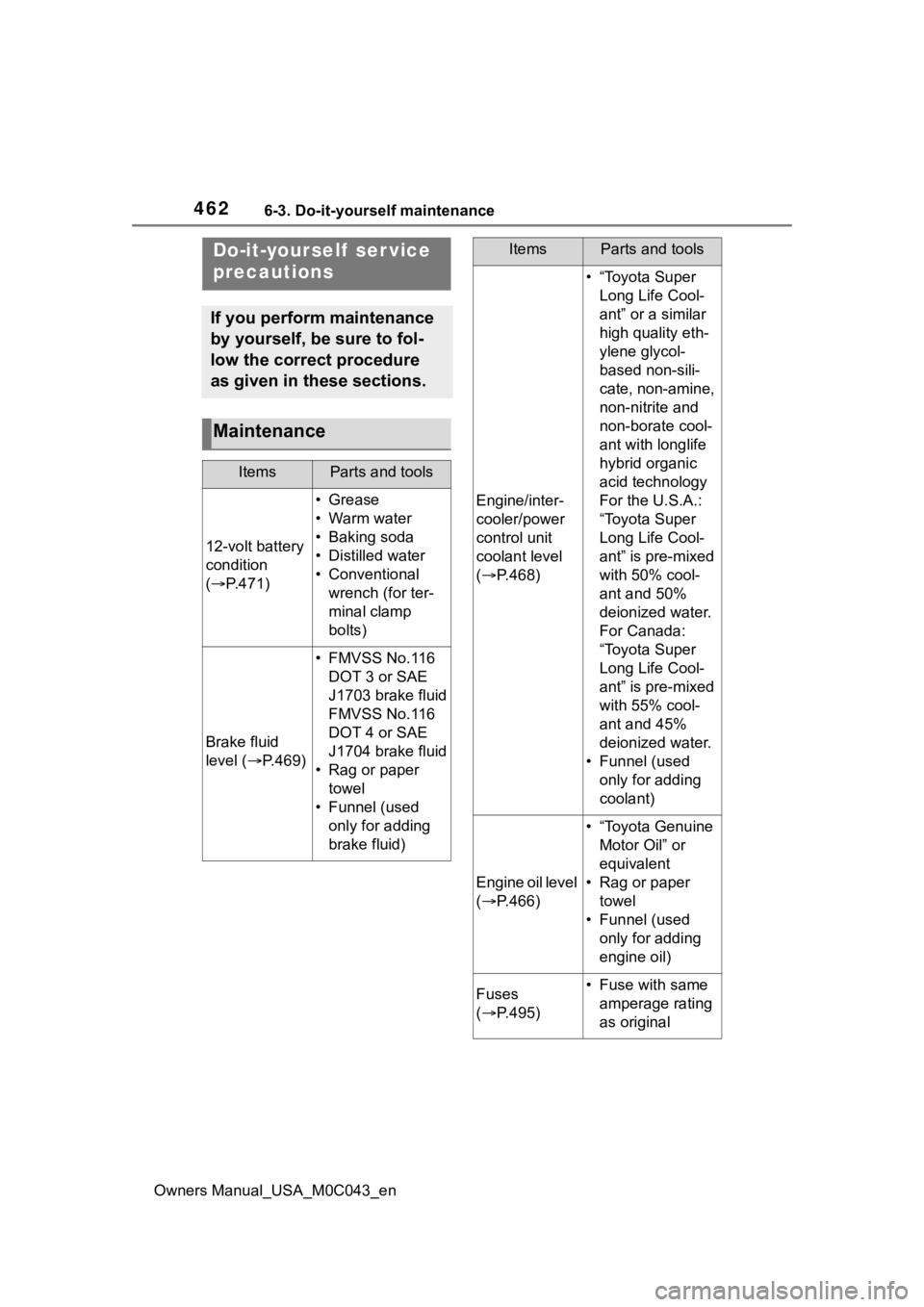
4626-3. Do-it-yourself maintenance
Owners Manual_USA_M0C043_en
6-3.Do-it-yourself maintenance
Do-it-yourself ser vice
precautions
If you perform maintenance
by yourself, be sure to fol-
low the correct procedure
as given in these sections.
Maintenance
ItemsParts and tools
12-volt battery
condition
( P.471)
•Grease
•Warm water
• Baking soda
• Distilled water
• Conventional
wrench (for ter-
minal clamp
bolts)
Brake fluid
level ( P.469)
• FMVSS No.116
DOT 3 or SAE
J1703 brake fluid
FMVSS No.116
DOT 4 or SAE
J1704 brake fluid
• Rag or paper towel
• Funnel (used only for adding
brake fluid)
Engine/inter-
cooler/power
control unit
coolant level
( P.468)
• “Toyota Super
Long Life Cool-
ant” or a similar
high quality eth-
ylene glycol-
based non-sili-
cate, non-amine,
non-nitrite and
non-borate cool-
ant with longlife
hybrid organic
acid technology
For the U.S.A.:
“Toyota Super
Long Life Cool-
ant” is pre-mixed
with 50% cool-
ant and 50%
deionized water.
For Canada:
“Toyota Super
Long Life Cool-
ant” is pre-mixed
with 55% cool-
ant and 45%
deionized water.
• Funnel (used only for adding
coolant)
Engine oil level
( P.466)
• “Toyota Genuine
Motor Oil” or
equivalent
• Rag or paper towel
• Funnel (used only for adding
engine oil)
Fuses
( P.495)• Fuse with same
amperage rating
as original
ItemsParts and tools
Page 465 of 628
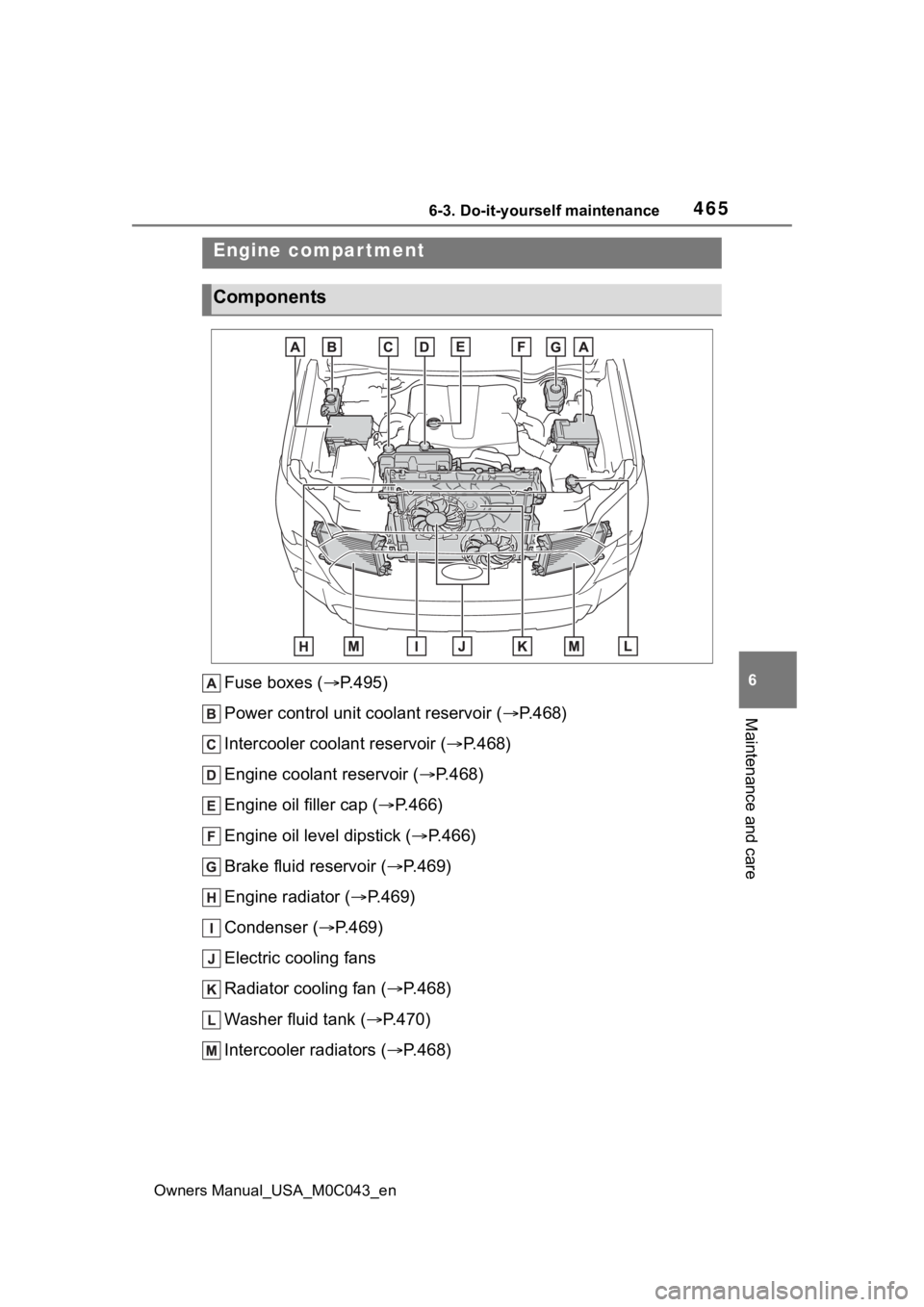
4656-3. Do-it-yourself maintenance
Owners Manual_USA_M0C043_en
6
Maintenance and care
Fuse boxes ( P.495)
Power control unit coolant reservoir ( P.468)
Intercooler coolant reservoir ( P.468)
Engine coolant reservoir ( P.468)
Engine oil filler cap ( P.466)
Engine oil level dipstick ( P.466)
Brake fluid reservoir ( P.469)
Engine radiator ( P.469)
Condenser ( P.469)
Electric cooling fans
Radiator cooling fan ( P.468)
Washer fluid tank ( P.470)
Intercooler radiators ( P.468)
Engine compar tment
Components
Page 495 of 628
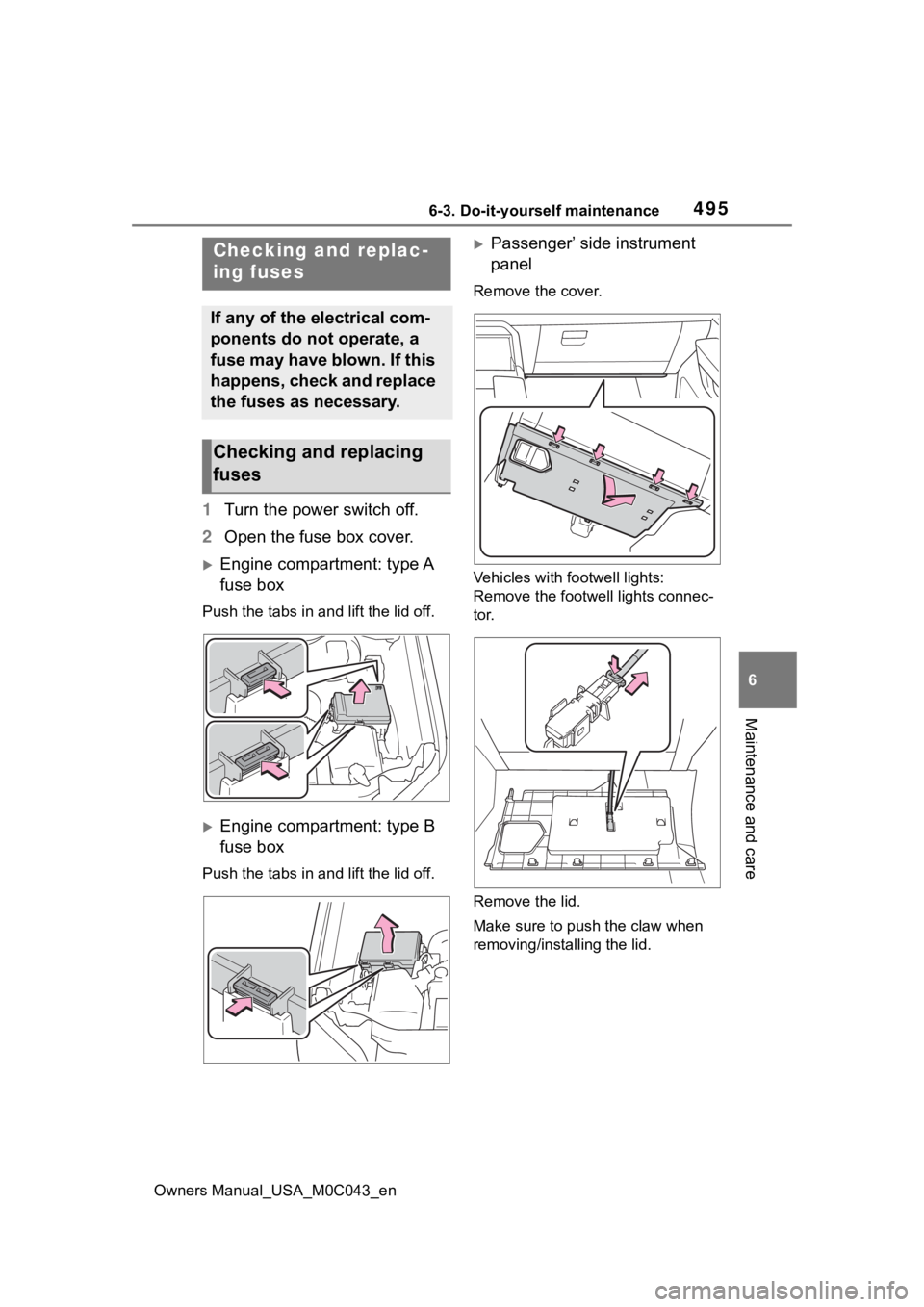
4956-3. Do-it-yourself maintenance
Owners Manual_USA_M0C043_en
6
Maintenance and care
1 Turn the power switch off.
2 Open the fuse box cover.
Engine compartment: type A
fuse box
Push the tabs in and lift the lid off.
Engine compartment: type B
fuse box
Push the tabs in and lift the lid off.
Passenger’ side instrument
panel
Remove the cover.
Vehicles with footwell lights:
Remove the footwell lights connec-
tor.
Remove the lid.
Make sure to push the claw when
removing/installing the lid.
Checking and replac-
ing fuses
If any of the electrical com-
ponents do not operate, a
fuse may have blown. If this
happens, check and replace
the fuses as necessary.
Checking and replacing
fuses
Page 496 of 628

4966-3. Do-it-yourself maintenance
Owners Manual_USA_M0C043_en
Luggage compartment
Slide the third se ats to the front-
most position. ( P.145)
Remove the left-hand side of the
luggage trim cover.
Remove the positive (+) battery ter-
minal cover.
3 Remove the fuse with the
pullout tool.
Only type A fuse can be removed using the pullout
tool.
4 Check if the fuse is blown.
Type A and B:
Replace the blown fuse with a new
fuse of an appropriate amperage
rating. The amperage rating can be
found on the fuse box lid.
Type C and D:
Contact your Toyota dealer.
Type A
Normal fuse
Blown fuse
Type B
Page 497 of 628
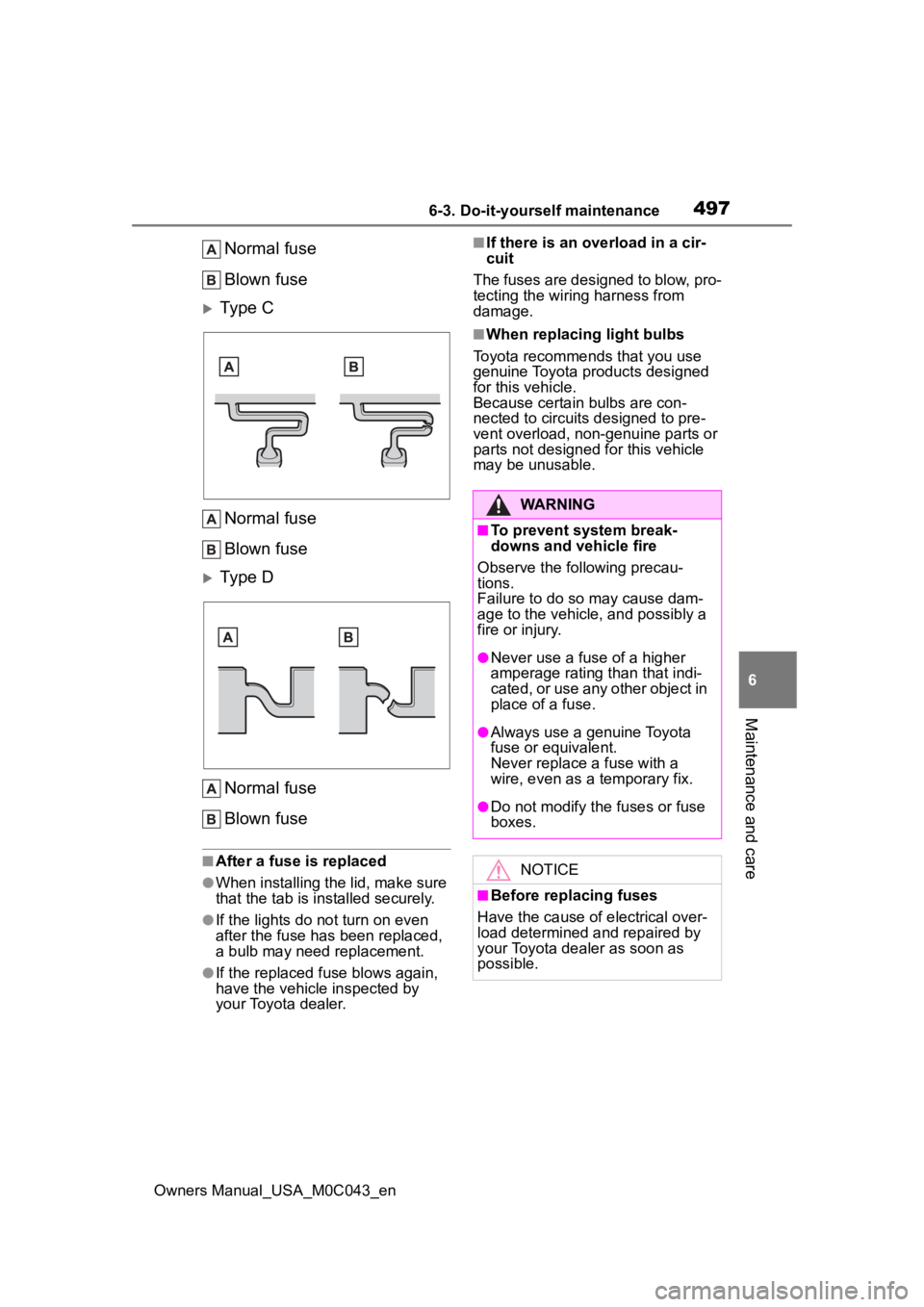
4976-3. Do-it-yourself maintenance
Owners Manual_USA_M0C043_en
6
Maintenance and care
Normal fuse
Blown fuse
Type C Normal fuse
Blown fuse
Type D
Normal fuse
Blown fuse
■After a fuse is replaced
●When installing the lid, make sure
that the tab is installed securely.
●If the lights do n ot turn on even
after the fuse has been replaced,
a bulb may need replacement.
●If the replaced fuse blows again,
have the vehicle inspected by
your Toyota dealer.
■If there is an ove rload in a cir-
cuit
The fuses are designed to blow, pro-
tecting the wiring harness from
damage.
■When replacing light bulbs
Toyota recommends that you use
genuine Toyota pr oducts designed
for this vehicle.
Because certain bulbs are con-
nected to circuits designed to pre-
vent overload, non-genuine parts or
parts not designed for this vehicle
may be unusable.
WARNING
■To prevent system break-
downs and vehicle fire
Observe the following precau-
tions.
Failure to do so may cause dam-
age to the vehicle, and possibly a
fire or injury.
●Never use a fuse of a higher
amperage rating than that indi-
cated, or use any other object in
place of a fuse.
●Always use a genuine Toyota
fuse or equivalent.
Never replace a fuse with a
wire, even as a temporary fix.
●Do not modify the fuses or fuse
boxes.
NOTICE
■Before replacing fuses
Have the cause of electrical over-
load determined and repaired by
your Toyota dealer as soon as
possible.
Page 532 of 628
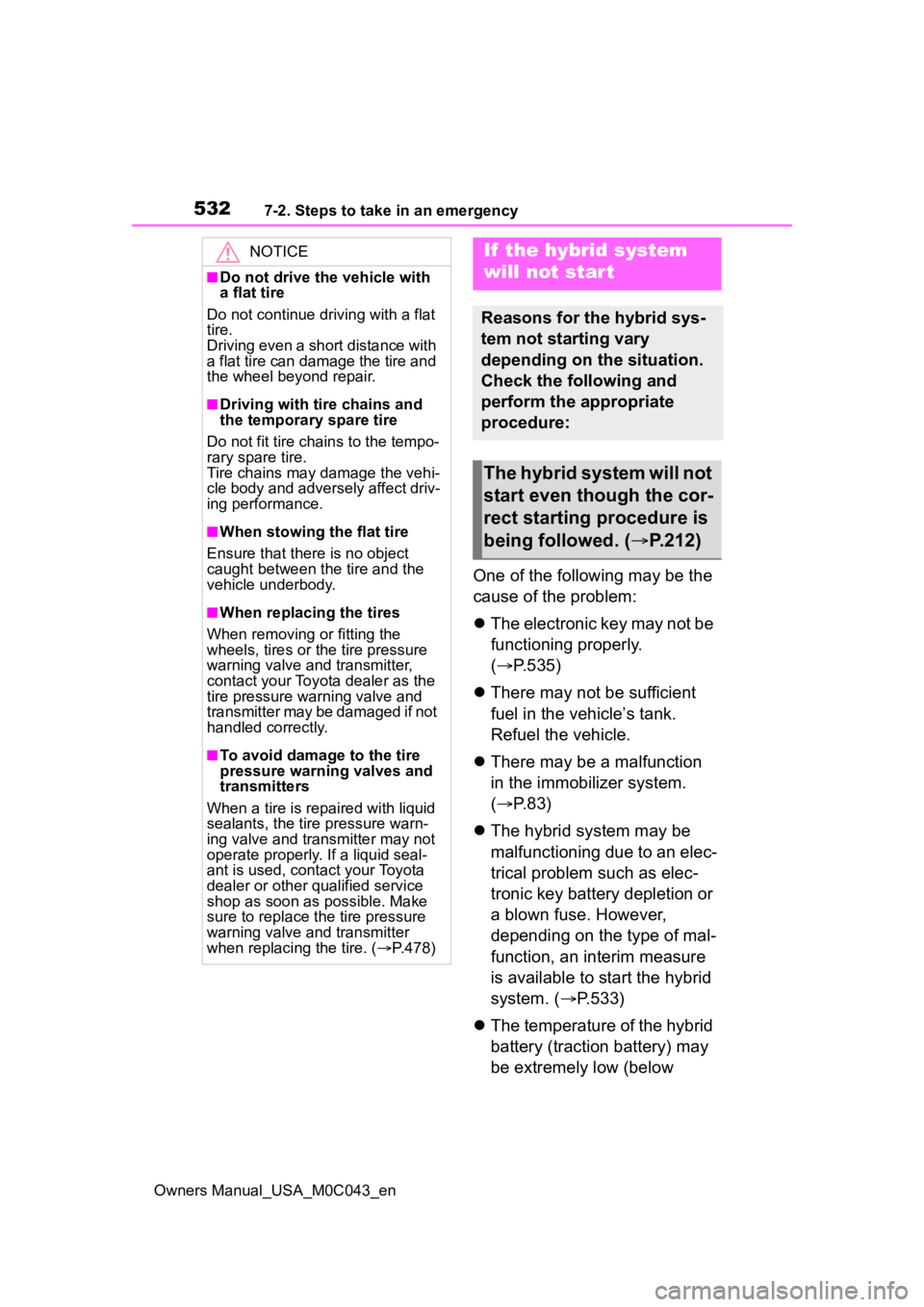
5327-2. Steps to take in an emergency
Owners Manual_USA_M0C043_en
One of the following may be the
cause of the problem:
The electronic key may not be
functioning properly.
( P.535)
There may not be sufficient
fuel in the vehicle’s tank.
Refuel the vehicle.
There may be a malfunction
in the immobilizer system.
( P.83)
The hybrid system may be
malfunctioning due to an elec-
trical problem such as elec-
tronic key battery depletion or
a blown fuse. However,
depending on the type of mal-
function, an interim measure
is available to start the hybrid
system. ( P.533)
The temperature of the hybrid
battery (traction battery) may
be extremely low (below
NOTICE
■Do not drive the vehicle with
a flat tire
Do not continue driving with a flat
tire.
Driving even a short distance with
a flat tire can damage the tire and
the wheel beyond repair.
■Driving with tire chains and
the temporary spare tire
Do not fit tire chains to the tempo-
rary spare tire.
Tire chains may damage the vehi-
cle body and adversely affect driv-
ing performance.
■When stowing the flat tire
Ensure that there is no object
caught between the tire and the
vehicle underbody.
■When replacing the tires
When removing or fitting the
wheels, tires or the tire pressure
warning valve and transmitter,
contact your Toyota dealer as the
tire pressure warning valve and
transmitter may be damaged if not
handled correctly.
■To avoid damage to the tire
pressure warning valves and
transmitters
When a tire is repaired with liquid
sealants, the tire pressure warn-
ing valve and transmitter may not
operate properly. If a liquid seal-
ant is used, contact your Toyota
dealer or other qualified service
shop as soon as possible. Make
sure to replace the tire pressure
warning valve and transmitter
when replaci ng the tire. (P.478)
If the hybrid system
will not star t
Reasons for the hybrid sys-
tem not starting vary
depending on the situation.
Check the following and
perform the appropriate
procedure:
The hybrid system will not
start even though the cor-
rect starting procedure is
being followed. ( P.212)
Page 538 of 628
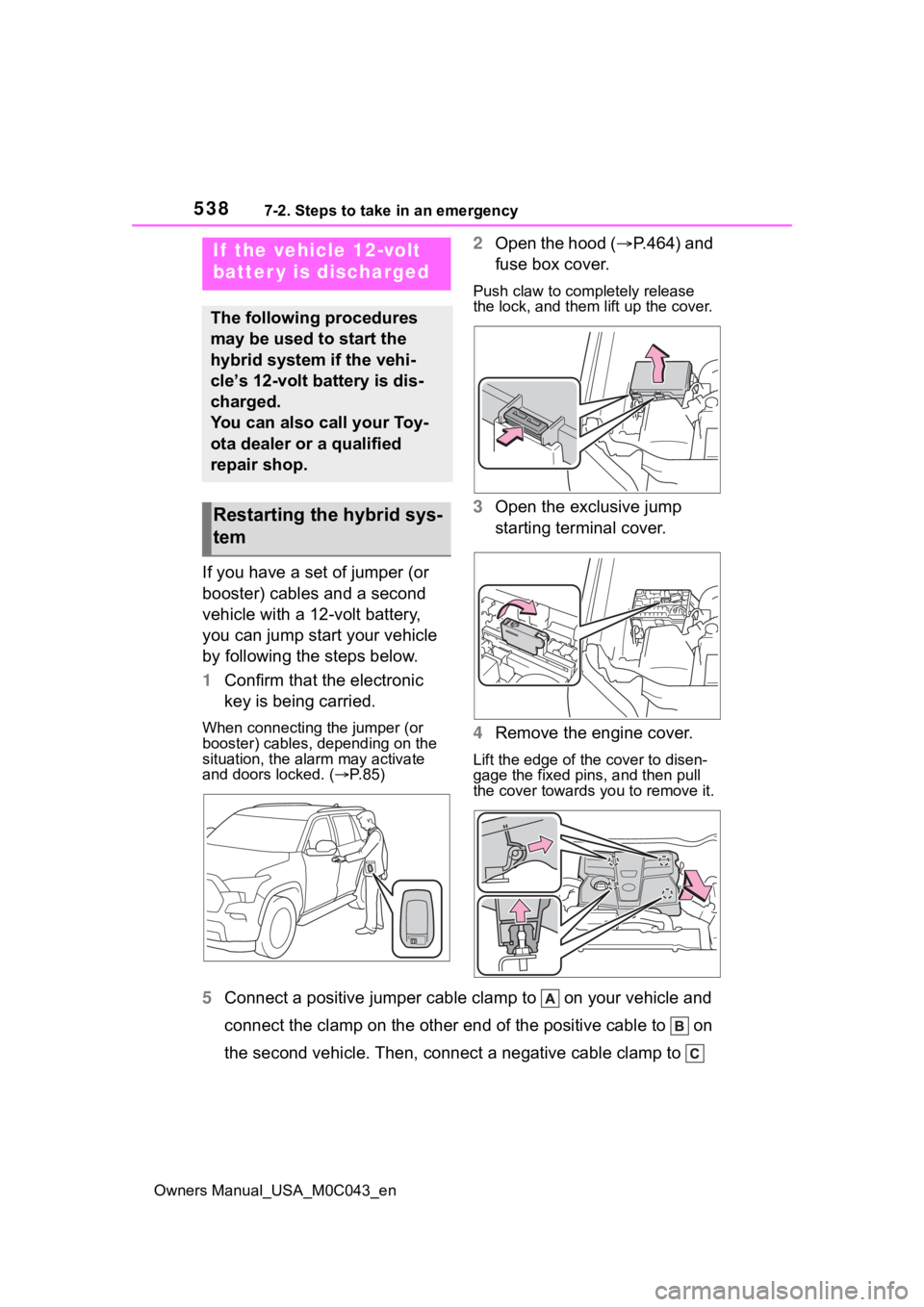
5387-2. Steps to take in an emergency
Owners Manual_USA_M0C043_en
If you have a set of jumper (or
booster) cables and a second
vehicle with a 12-volt battery,
you can jump start your vehicle
by following the steps below.
1Confirm that the electronic
key is being carried.
When connecting the jumper (or
booster) cables, depending on the
situation, the ala rm may activate
and doors locked. ( P. 8 5 )
2 Open the hood ( P.464) and
fuse box cover.
Push claw to completely release
the lock, and them lift up the cover.
3 Open the exclusive jump
starting terminal cover.
4 Remove the engine cover.
Lift the edge of the cover to disen-
gage the fixed pins, and then pull
the cover towards you to remove it.
5 Connect a positive jumper cabl e clamp to on your vehicle and
connect the clamp on the other end of the positive cable to on
the second vehicle. Then, connect a negative cable clamp to
If the vehicle 12-volt
batter y is discharged
The following procedures
may be used to start the
hybrid system if the vehi-
cle’s 12-volt battery is dis-
charged.
You can also call your Toy-
ota dealer or a qualified
repair shop.
Restarting the hybrid sys-
tem